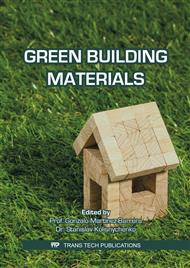p.13
p.23
p.28
p.35
p.43
p.51
p.60
p.72
p.81
Cement-Lime Plaster with PCM Addition – A Perspective Material for Moderation of Interior Climate
Abstract:
The interior temperature and relative humidity are important parameters in order to achieve healthy, comfortable, sustainable, and energy efficient indoor environment. In this paper, cement-lime plaster with PCM addition is studied as a perspective material for moderation of indoor temperature and humidity fluctuations. Commercial dry plaster mixture is modified by PCM addition based on the water dispersion of polymer microencapsulated paraffinic wax. The dosage of PCM is 4, 8, and 12 mass% related to the dry mass of plaster mixture. For the developed plasters, basic physical, thermal and hygric properties are measured. Incorporation of PCM into the cement-lime matrix lead to the substantial increase of the heat storage capacity in dependence on temperature as well as to the improvement of moisture buffer value of the newly developed composites which brings efficient way to reduce daily moisture variations. The obtained data can find use in attaining the higher indoor climate stability with lower energy consumption and operational cost.
Info:
Periodical:
Pages:
43-50
Citation:
Online since:
September 2016
Authors:
Price:
Сopyright:
© 2016 Trans Tech Publications Ltd. All Rights Reserved
Share:
Citation:



